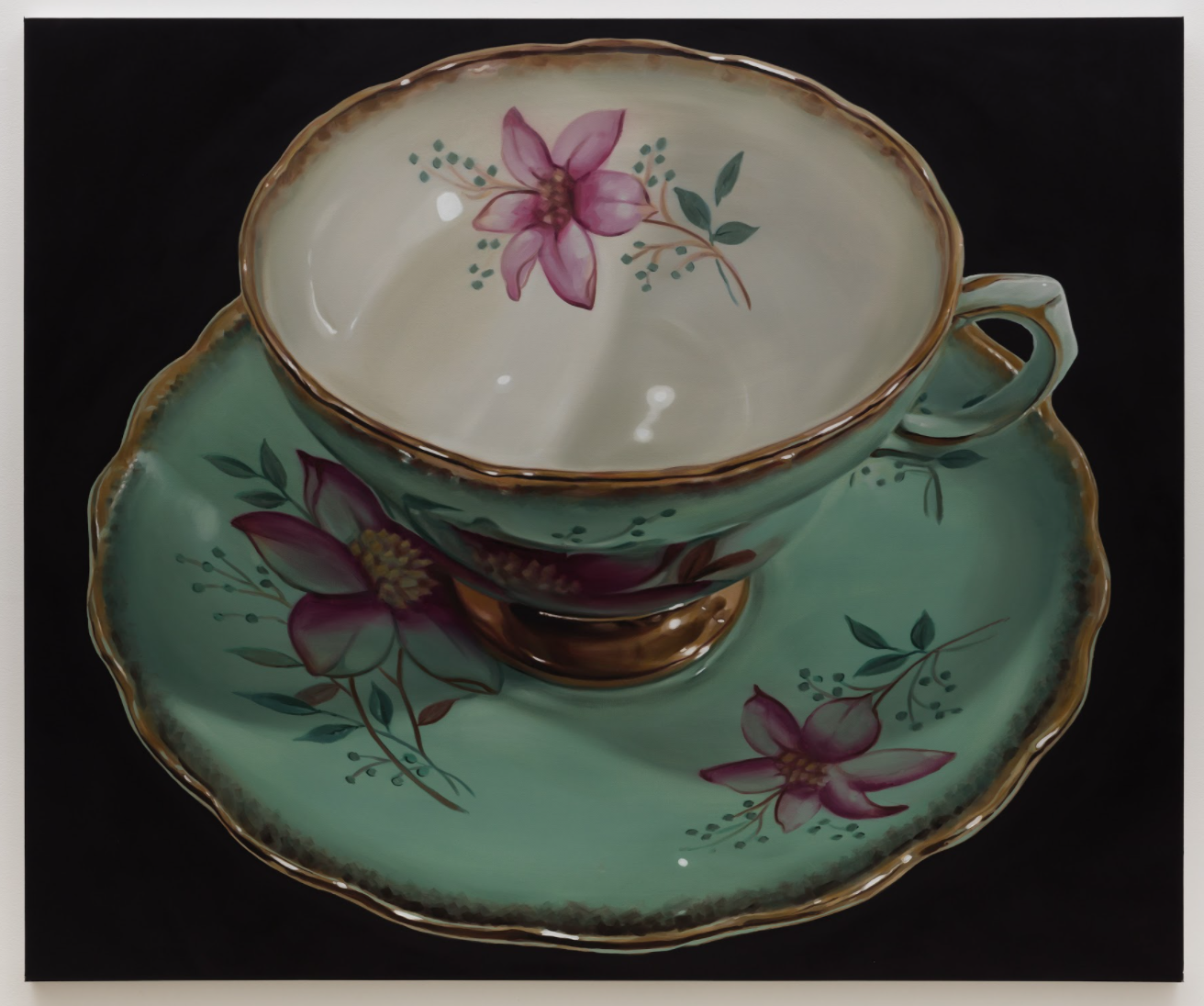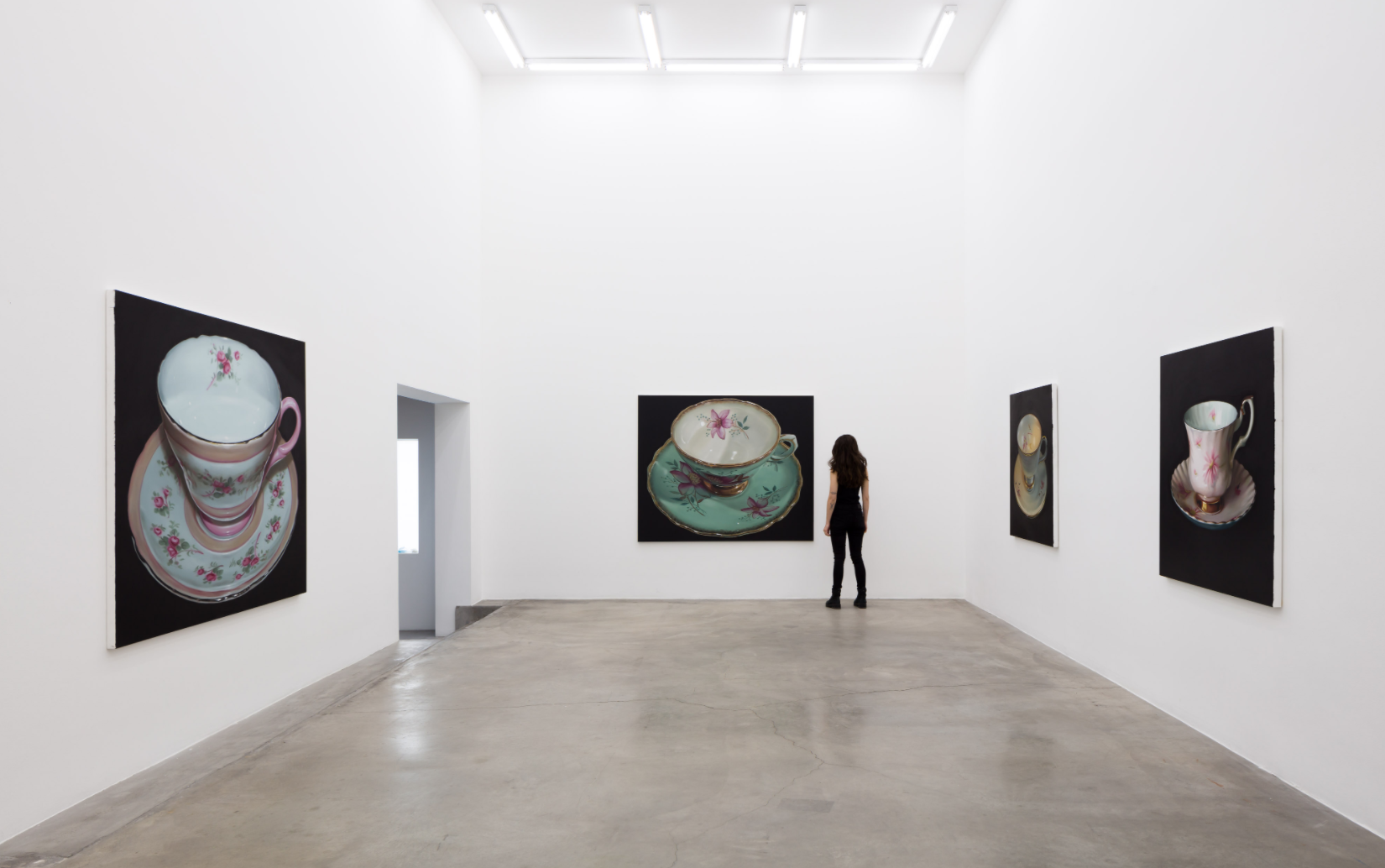A Google search for teacup reveals delicate fluted cups and saucers, many decorated with floral patterns. The association is afternoon tea in England, a formal spread with snacks and fine china. The sources for Robert Russell’s “Teacups” paintings are random photographs posted online. He collects images from eBay and estate sales to amass an archive that he adapts to create his works. Found images from the internet have been central to Russell’s work. He previously made paintings of other men named Robert Russell, as well as a series of paintings of artist’s monographs where the cover of each book featured a picture of the artist’s work and their signature— all culled from online sources. Russell’s work is simultaneously rooted in painting and in conceptual art. He is invested in the ideas of reproduction, seriality, and transformation, as each of his projects presents variations on a theme. That being said, he is also an exceptionally accomplished painter.
Though he begins with a tiny computer image, many of Russell’s final works are quite large, ranging from 48″x48″ to 70″x80.” Each cup and saucer combination is centered on the canvas. The remaining space is painted a lush deep black. Whatever else might have been in the original image has been overpainted so the focus is on the ornate shape and decorative motif. The teacups Russell has chosen to reproduce are shot from slightly above so both the saucer and inside of the cup are visible. They are covered with either bouquets or single flowers which allow the paintings to reference traditional still lives.

Robert Russell, Teacup #10, (2020). Oil on canvas, 60″x60.” Image courtesy of Anat Egbi.
Teacup #13, (2020) has a pink rose leaning left and stemming from the center of a slightly green tinted, porcelain cup. A purple and yellow iris tilts to the right. The gold-rimmed cup sits upon a similarly embellished saucer. Russell has perfectly captured the highlights bouncing off the rims as well as the shimmering glows within objects. In Teacup #10, (2020) Russell indulges in contrasting surfaces and textures of black. It depicts a tall, black glazed cup with a pink rose on its side. The white interior of the cup is topped by a gold band. The edge of the black saucer and bottom of the cup are likewise trimmed with gold. Again, Russell has meticulously rendered the details of the flower, as well as light reflections glinting on both the cup and saucer against the flat black background that surrounds it. The paintings are photorealistic, specifically in Russell’s portrayal of light and the flowers, and also impressionistic, as sometimes Russell fills areas with looser textured brushstrokes.

Robert Russell Teacup #8, (2020). Oil on canvas, 60″x72.” Image courtesy of Anat Egbi.
What is uncanny about Russell’s teacups is their size. Each object has been enlarged to such a monumental scale that they lose their preciousness and delicacy to become anomalies — though beautiful, they are also monstrous. Like Robert Therrien’s large-scale sculptures of everyday objects, Russell transforms the commonplace into something unusual. That each teacup has been removed from a context and presented against black adds to a sense of drama and disorientation. The works may draw from 17th-Century Dutch vanitas still lifes, many of which were painted against a dark, neutral ground. However, unlike vanitas paintings, Russell’s renderings do not seem to be centered on death, as they allude to something pleasurable in life — the drinking of tea from a fancy cup. Russell’s paintings are a celebration of skill that also present stasis. The deep impenetrable black could sign for the pandemic, its unsettling effects, and the void it has created. The flowers that decorate the teacups could be seen as memorials commemorating those who have passed— as flowers are often left at gravesites. However, they could also be interpreted as images of life and hope. Either way, Russell has created a body of evocative and powerful paintings that resonate long after viewing.
Robert Russell “Teacups”
Anat Ebgi
January 23 – March 6, 2021


